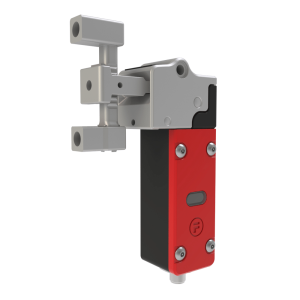Producción de metales
La industria de producción de metales implica diversas aplicaciones de maquinaria y condiciones difíciles, desde transformaciones a alta temperatura hasta trenes de laminación y complejos equipos de procesamiento. Entre los riesgos comunes se incluyen la exposición a metal fundido, maquinaria pesada y entornos difíciles que pueden provocar corrosión y problemas de integridad estructural. Proteger al personal de estos peligros es crucial.
En Fortress, aprovechamos nuestra amplia experiencia en seguridad de maquinaria y oferta de productos para diseñar soluciones de seguridad a medida, ayudando a los principales fabricantes de metal a cumplir sus requisitos específicos y proteger a su personal con productos que puedan soportar las exigentes condiciones de la industria.

Cobertura de grandes áreas
Aplique secuencias a grandes distancias y en zonas donde el cableado no sea práctico y la visibilidad sea limitada.
Soluciones en metal y acero inoxidable
Ideal para entornos extremos en los que se requiere resistencia a las altas temperaturas y a la corrosión.
en red Soluciones
Comunique las E/S estándar y de seguridad a través de redes industriales, gestione los permisos de acceso e impida el acceso no autorizado.
Productos totalmente configurables
Diseñe soluciones de seguridad a medida para satisfacer los requisitos específicos de cualquier aplicación.
Minimizar inactividad y sustituciones
Productos robustos fabricados para durar décadas, incluso en las aplicaciones más exigentes y los entornos más duros.
Alcance mundial
Con oficinas en todo el mundo y una amplia red de socios de confianza, Fortress ofrece asistencia en todo el mundo.
Cobertura de grandes áreas
Aplique secuencias a grandes distancias y en zonas donde el cableado no sea práctico y la visibilidad sea limitada.
Soluciones en metal y acero inoxidable
Ideal para entornos extremos en los que se requiere resistencia a las altas temperaturas y a la corrosión.
en red Soluciones
Comunique las E/S estándar y de seguridad a través de redes industriales, gestione los permisos de acceso e impida el acceso no autorizado.
Productos totalmente configurables
Diseñe soluciones de seguridad a medida para satisfacer los requisitos específicos de cualquier aplicación.
Minimizar inactividad y sustituciones
Productos robustos fabricados para durar décadas, incluso en las aplicaciones más exigentes y los entornos más duros.
Alcance mundial
Con oficinas en todo el mundo y una amplia red de socios de confianza, Fortress ofrece asistencia en todo el mundo.
Empiece a trabajar en su solución personalizada
Case Study-
OPEX
Soluciones de seguridad basadas en EtherCAT en automatización de almacenes
Fortress ofreció dispositivos para acceso a pasillos y capacidad de E/S de seguridad remota mediante dispositivos capaces de comunicarse a través de EtherCAT. Se ofrecieron tres tipos de unidades de la gama amGard pro, que permiten el acceso al pasillo, el acceso lateral y la E/S remota, respectivamente.
Productos utilizados
amGardpro
Industria
Almacenamiento automatizado


¿Quiénes son Duferco?
El Grupo Duferco es líder mundial en producción de acero, energía, transporte marítimo
e innovación.
Case Study-
OPEX
Soluciones de seguridad basadas en EtherCAT en automatización de almacenes
Fortress ofreció dispositivos para acceso a pasillos y capacidad de E/S de seguridad remota mediante dispositivos capaces de comunicarse a través de EtherCAT. Se ofrecieron tres tipos de unidades de la gama amGard pro, que permiten el acceso al pasillo, el acceso lateral y la E/S remota, respectivamente.
Productos utilizados
amGardpro
Industria
Almacenamiento automatizado


¿Quiénes son Tata Steel?
Tata Steel es uno de los principales fabricantes de acero del mundo, conocido por sus operaciones integradas, sus prácticas sostenibles y su fuerte presencia en los sectores de la automoción, la construcción y las infraestructuras.
Gama de productos recomendados
amGardpro
Los controles por pulsador, las opciones de teclas atrapadas y la conectividad de red pueden combinarse en una sola unidad.
Altamente configurable
Reducir las sustituciones y inactividad
Todos los controles en un solo lugar
Conectividad de red
Gama de productos recomendados
mGard
Enclavamientos mecánicos con llave atrapada diseñados para hacer cumplir secuencias de llaves específicas, especialmente en aplicaciones con múltiples fuentes de energía. Rentables, fáciles de instalar y mantener e ideales para zonas de difícil acceso con cables.
Aplicar secuencias
Control de la energía peligrosa
Minimizar la máquina inactividad
Sin necesidad de cableado
Noticias y datos
¿No sabe por dónde empezar? Estamos aquí para ayudarle
Nuestro equipo de expertos está aquí para ayudarle a crear la solución adecuada para usted. Pueden analizar su sector y las necesidades específicas de su aplicación para ofrecerle recomendaciones sobre cómo los productos Fortress podrían beneficiar a su instalación.















